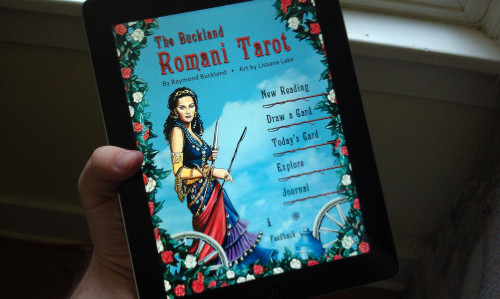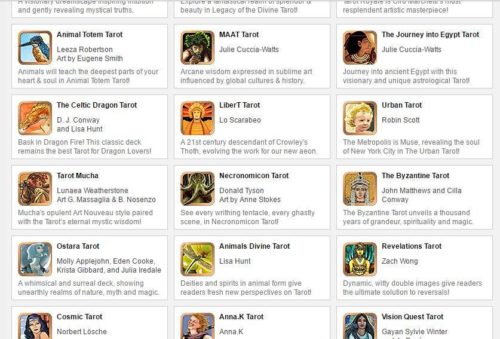[Terence P. Ward is one of our editors and talented weekly news writers. If you like his work and our daily news service, consider donating to The Wild Hunt. Each and every day, you will receive original content, both news and commentary, with a focus on Pagans, Heathens and polytheists worldwide. Your support makes it all happen, and every dollar counts. This is your community; TWH is your community news source. Donate today and share our link! Thank you.]
SILVER SPRING, Md. — Some experienced professional tarot readers will sniff at the idea of using a tarot app for divination, an idea that was explored by Wild Hunt columnist last month. Caroline Kenner, one of the people behind the Fool’s Dog suite of tarot apps, understands where they are coming from. Together with her husband Jason Linhart, an experienced programmer, she has worked to provide what she describes as simply an electronic tool to complement physical cards and professional readers.

Buckland’s Romani Tarot iPad app title screen. [Courtesy Photo]
Many tarot apps available on the market have “programming shortcuts to shorten the time to market,” Kenner explained. However, the Kenners’ goal of supporting the art and the reading community represents a different approach. She brought her three decades’ experience as an intuitive reader to bear on the problem, and combined it with her husband’s programming prowess, as well as a magical spell designed to meld the two.
Linhart has, according to Kenner, been programming since the age of 11 and writing code for Apple products since before the Macintosh was first rolled out in 1984. “He could tell you the number and description of any card, but he couldn’t interpret them,” she explained. “He liked them because of the patterns,” an interest which has also led him to develop a successful line of sudoku apps.
When the couple decided to build better tarot apps, each of their skills were needed, but they also went out into the community for guidance. “We went to our reader friends,” she recalled, saying that after so many years in the community, “we had a million of those, and a thousand who read professionally.”
The couple hosted open houses for readers of all skill levels, inviting them to test, poke, and prod. Artist Helena Domenic was the first to sign on and agree to allow her work to go digital. The first Fool’s Dog decks came out in 2011. Two years later, Raymond Buckland’s Romani Tarot joined the suite. To date, 60 decks have been added.

[Screenshot from Fool’s Dog website showing some of the available decks]
“Physical decks can run upwards of $30,” she said. “That’s a commitment. When I was reading, I would sometimes buy a deck I saw, but it really didn’t click with me. This is a lower financial commitment, and people can pick the decks that really sing to them to buy physically.” A links within the app is available to do just that. These links lead directly to creators’ own websites or to Amazon, making that next step an easy one to accomplish.
Fool’s Dog has also created some decks that had very small print runs, generally when funded by a Kickstarter campaign, and were never picked up by a major publisher.
Along with flexibility of price, there are other benefits in digital deck production. Deck creators aren’t stunted by truncated descriptions, nor are readers. The full text of a deck’s instructions are available unless the creator specifically doesn’t want that to be the case. In addition, there’s space for app owners to add their own meanings instead having to rely solely on the boilerplate.
Layouts are similar: a variety of common ones are built right in, as well as any that are unique to a particular deck. For example, the Zombie Tarot brings with it the “gravestone” layout that’s detailed in the physical instructions. As with card meanings, there is a free form option for layouts, which gives more flexibility than one might anticipate from a computer.
One thing computers do very well is remember information; every reading done through these apps are automatically added to a journal, and may be emailed. Readers can manually input a physical spread to send it to a client, as well.
The Kenners have taken pains to meld tarot and technology in ways never attempted before. Linhart started with a randomizer he developed more than a decade ago, and then added further randomization based on the timing of user actions such as tapping and swiping.
“When the user actions are timed to the nanosecond, the low order bits are truly random,” Kenner said. “This seamless interface between user and tarot program is very successful at opening the door to synchronicity.” Indeed, the apps allows for two different kinds of electronic shuffling, as well as deck cuts, to increase the random factors introduced.
![Wildwood Tarot app [Photo Credit: H. Greene]](https://wildhunt.org/wp-content/uploads/2016/08/20160806_111339-500x366.jpg)
Wildwood Tarot app [Photo Credit: H. Greene]
I performed a ritual to charge and empower a sigil created from the word “divination” plotted onto the magick square of the moon that is linked to the tarot app. There is a physical world version of the sigil on paper that is being kept in a safe place on an altar so long as the app is in use.
The resulting numbers are written directly into the app code, such that users never see it.
“Top-rated programming, top-rated spell work, and a way to help Pagan elders,” summarized Kenner. That last part is close to her heart, because she’s seen that those elders tend to be “magical people who often struggle with business and money.” The paying of royalties is one way to allow for more community support of their lifelong contributions.
“I’m worried about how many of us have led unusual lives that don’t necessarily add up to retirement funds,” Kenner explained.
Who is using Fool’s Dog apps? According to Kenner, quite a few people, including those young enough that they have grown up in the light of a screen, but also more experienced and professional readers. “People often use it while in transit,” she explained, such as while commuting to work while desiring to perform a daily or self-reading. It’s ideal for that kind of compact situation, she said, while the physical deck remains at home or in one’s purse.
It’s not, however, intended to replace a reader’s intuition with boilerplate, any more than someone with no experience can be expected to read a physical deck simply by referring to the booklet. “It’s a tool of empowerment,” Kenner said, “but it can never replace that rapport. It’s just a different interface.”
The Wild Hunt is not responsible for links to external content.
To join a conversation on this post:
Visit our The Wild Hunt subreddit! Point your favorite browser to https://www.reddit.com/r/The_Wild_Hunt_News/, then click “JOIN”. Make sure to click the bell, too, to be notified of new articles posted to our subreddit.

Neatokeen–must check them out.
Pingback: The Fool’s Dog Tarot App(s) Review | Oak and Sage Tarot